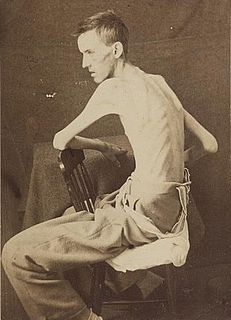
California's involvement in the American Civil War included sending gold east, recruiting volunteer combat units to replace regular forces in territories of the Western United States, maintaining and building numerous camps and fortifications, suppressing secessionist activity and securing the New Mexico Territory against the Confederacy. The State of California did not send its units east, but many citizens traveled east and joined the Union Army there, some of whom became famous. California's Volunteers also conducted many operations against the native peoples within the state and in the other Western territories of the Departments of the Pacific and New Mexico.

The Indiana National Guard is the armed force of the state of Indiana. It consists of the Indiana Army National Guard and the Indiana Air National Guard, and is part of the larger Army National Guard and the Air National Guard. With roots dating back to 1801, Indiana units first served in a national conflict in 1846 during the Mexican–American War, and were reorganized into their current configuration in 1903. Since then the guard has served at home and abroad as a part of multiple wars, disaster relief actions, and putting down strikes and riots.
The Battle of Rowlett's Station was a land battle in the American Civil War, fought at the railroad whistle-stop of Rowlett's in Hart County, Kentucky, on December 17, 1861. The outcome was inconclusive, although the Union Army continued to hold its objective, a railroad bridge across the Green River.

The 2nd Regiment Indiana Cavalry, also designated the 41st Regiment Indiana Infantry or the 41st Regiment Indiana Volunteers, was the first complete cavalry regiment raised in the U.S. state of Indiana to fight in the American Civil War.

The 28th Regiment United States Colored Troops, also called the 28th Regiment Indiana Infantry (Colored),1 was an African American combat unit from the state of Indiana that fought in the American Civil War.

The 3rd Regiment Indiana Cavalry, also designated the 45th Regiment Indiana Infantry or the 45th Regiment Indiana Volunteers was a military unit from the U.S. state of Indiana that participated in the American Civil War. It consisted of two separate "wings" that never operated together:
The 6th Indiana Infantry Regiment was an infantry regiment from the State of Indiana that served in the Union Army during the American Civil War. This regiment was the senior Indiana regiment of the Civil War, as it was numbered first in sequence after the five Indiana volunteer regiments which had served in the Mexican–American War. The regiment was originally mustered-in for a three-month period of service between April and August 1861, but after its initial term of service had expired it was re-formed in September 1861 for a further three-year period, before being mustered out in September 1864.

Ebenezer Dumont was a U.S. Representative from Indiana, as well as a general in the Union Army during the American Civil War.

Indiana, a state in the Midwest, played an important role in supporting the Union during the American Civil War. Despite anti-war activity within the state, and southern Indiana's ancestral ties to the South, Indiana was a strong supporter of the Union. Indiana contributed approximately 210,000 Union soldiers, sailors, and marines. Indiana's soldiers served in 308 military engagements during the war; the majority of them in the western theater, between the Mississippi River and the Appalachian Mountains. Indiana's war-related deaths reached 25,028. Its state government provided funds to purchase equipment, food, and supplies for troops in the field. Indiana, an agriculturally rich state containing the fifth-highest population in the Union, was critical to the North's success due to its geographical location, large population, and agricultural production. Indiana residents, also known as Hoosiers, supplied the Union with manpower for the war effort, a railroad network and access to the Ohio River and the Great Lakes, and agricultural products such as grain and livestock. The state experienced two minor raids by Confederate forces, and one major raid in 1863, which caused a brief panic in southern portions of the state and its capital city, Indianapolis.

Shelby's Iron Brigade, also known as the Missouri Iron Brigade, was a Confederate cavalry brigade, led by Brigadier General Joseph O. Shelby, in the Trans-Mississippi Theater of the American Civil War.
The 12th Regiment Indiana Infantry was an infantry regiment in the Union Army during the American Civil War.
The Army of Occupation was the name of the U.S. Army commanded by Zachary Taylor during the Mexican–American War.

The 151st Infantry Regiment is an infantry unit in the Indiana National Guard, part of the 76th Infantry Brigade Combat Team (Separate).
The 10th Regiment Indiana Cavalry, also designated the 125th Indiana Regiment, was a Cavalry Regiment raised in southern Indiana to fight in the American Civil War.

The 65th Regiment Indiana Infantry, was organized in Princeton and recruited throughout the southern Indiana counties to fight in the American Civil War.
The following list is a Bibliography of American Civil War Union military unit histories. More details on each book are available at WorldCat.















